When people think of Japanese tea or cha 茶, they usually think of matcha, but there’s so much more to explore! In this blog, I’ll take you through some amazing Japanese teas, from green and black and even oolong. I’ll also break down what makes them different from other teas out from around the world and what’s unique about Japanese teas! So grab a cup, get comfy, and enjoy the read!
Here’s a quick crash course on tea and what makes each type different. Believe it or not, all tea, no matter where it’s from, comes from the same plant (Camellia sinensis). The reason we have different types of tea, like green tea, black tea, and even fermented tea, comes down to how they’re processing.
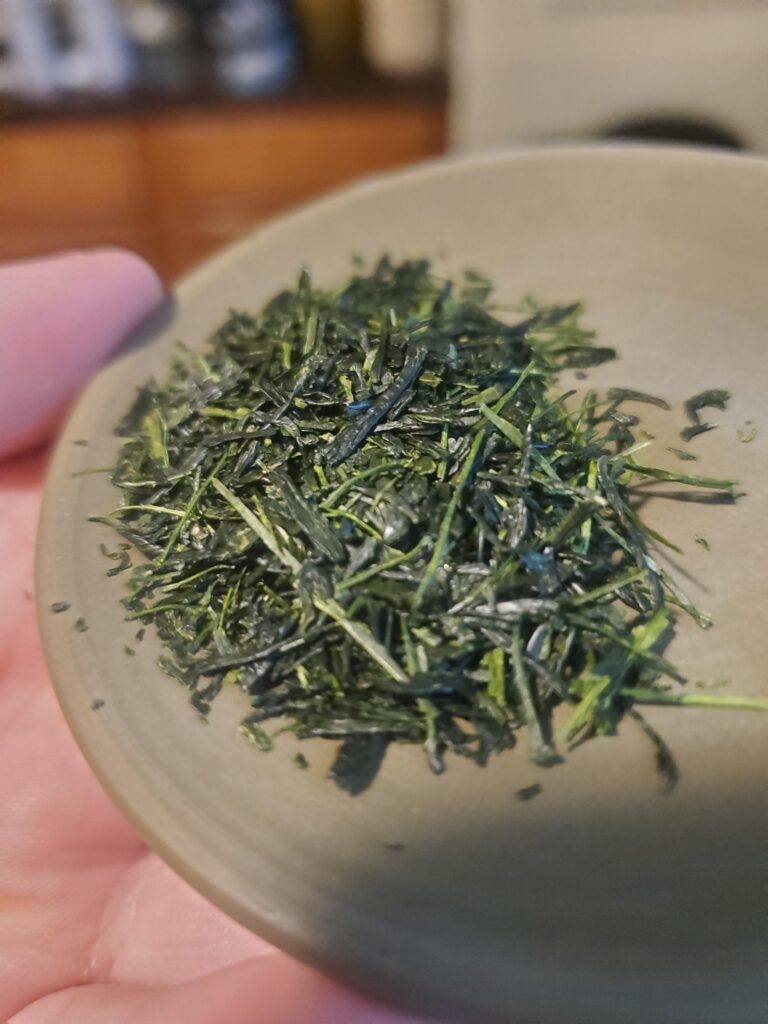
Green Tea お茶
Japan is famous for its green tea. You’ve probably had sencha or matcha before, both are types of green tea, even though they’re a bit different. Sencha is known for its distinctive needle-like shape, while matcha stands out as a fine powder. In fact, in Japanese, matcha literally means “powdered tea.” and Sencha which translates to “infused tea” (we put the tea in hot water to infuse.)
Green tea in Japan is harvested throughout the year, with three main harvest seasons. The spring harvest is considered the best, producing the highest quality ceremonial grade matcha and the highest quality shaded and unshaded sencha.
When I was in Japan, I was lucky enough to experience tea harvesting firsthand and learn all about the process. There are so many different varieties and techniques when it comes to Japanese tea, but one of the most unique features is that signature needle shape and, of course the taste.
Most Japanese green teas have a rich umami flavor with a natural sweetness. While some can be a bit astringent or bitter, that classic umami, sweet, and grassy profile is what makes them stand out. This distinct taste comes from some key practices: steaming, pan firing, shading, and using different Cultivars.
Steaming the leaves to stop oxidation tea leaves that are steamed are more green and have a more green taste than other tea leaves are pan fried to stop oxidation at least in my experience.
Pan firing is a traditional method used in tea processing. This method stops oxidation, and it’s usually done by hand in a wok over an open flame. This method gives the tea a unique flavor for Japanese tea. It has a more nutty and roasted flavor than other green teas from Japan.
Shading the tea plants for weeks before harvest reduces sunlight exposure, making the tea smoother and less bitter. This is because it boosts the production of L-theanine, an amino acid responsible for that savory umami flavor, while lowering the catechin level. These catechins contribute to bitterness, leading to the tea’s umami and sweet flavors.
Cultivars
The flavor of tea can vary depending on the cultivar, which is a specific variety of the tea plant. Just like wine grapes, tea plants have many different cultivars, each with distinct characteristics.
Some common Japanese matcha cultivars are:
Okumidori is known for its smooth, mild flavor.
Samidori offers a sweet, mellow taste.
Yabukita: One of the most widely used cultivars in Japan, known for its balanced flavor with a touch of astringency.
Each cultivar brings something unique to the table, adding to the complexity and variety of tea.
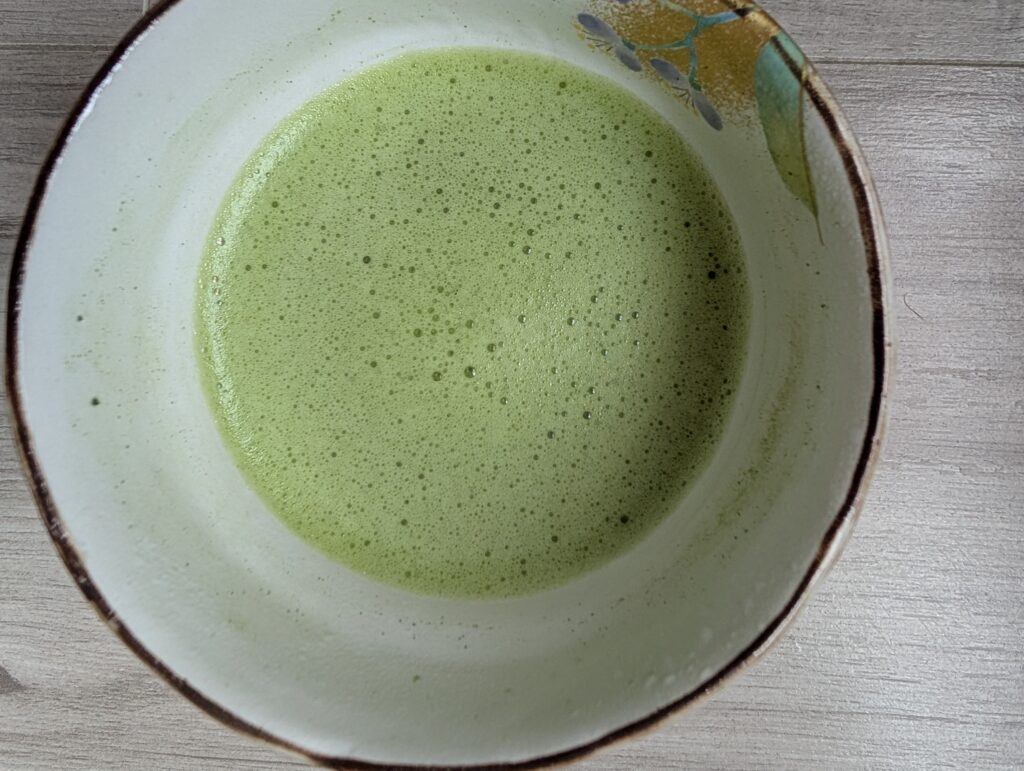
Types of Matcha
In my experience, there are four different types of matcha, each with its own purpose and flavor profile.
Basic Grade
This type of matcha is more bitter and astringent, making it perfect for baking or matcha lattes with added sweeteners. Its stronger flavor holds up well when mixed with other ingredients. Basic grade matcha is usually harvested in late summer and autumn, during which time the tea plants are preparing for winter. As a result, the leaves tend to be a bit more astringent and bitter, giving the matcha a bolder, more bitter flavor.
Excellent Grade & Premium Grade
These grades fall somewhere between basic and ceremonial matcha. They’re often a blend of both (ceremony grade and basic) and are great for matcha lattes or everyday matcha drinkers. Which one you prefer really depends on how you like your matcha. Some enjoy a flavor that’s more balanced, offering a middle ground between the boldness of basic grade and the smoothness of ceremonial grade.
Another bonus? These grades are often more budget-friendly while still offering good quality. Flavor-wise, they typically have a nice balance of umami and bitterness.
Ceremonial Grade
This is the highest quality matcha the best of the best. Ceremonial grade matcha is known for its rich umami flavor and natural sweetness. It’s smooth, vibrant, and perfect for traditional whisked matcha without any added ingredients. The reason it’s called “ceremonial grade” is because it’s the type of matcha traditionally used in Japanese tea ceremonies.
Ceremonial grade matcha is harvested in the spring, when the tea plants are most tender and nutritionally rich. This makes it ideal for creating a high-quality, flavorful matcha experience.
So when you are choosing a matcha you may want to look at the cultivar and grade to see which one you would like best!
It doesn’t stop there.. Let’s talk about sencha! 煎茶
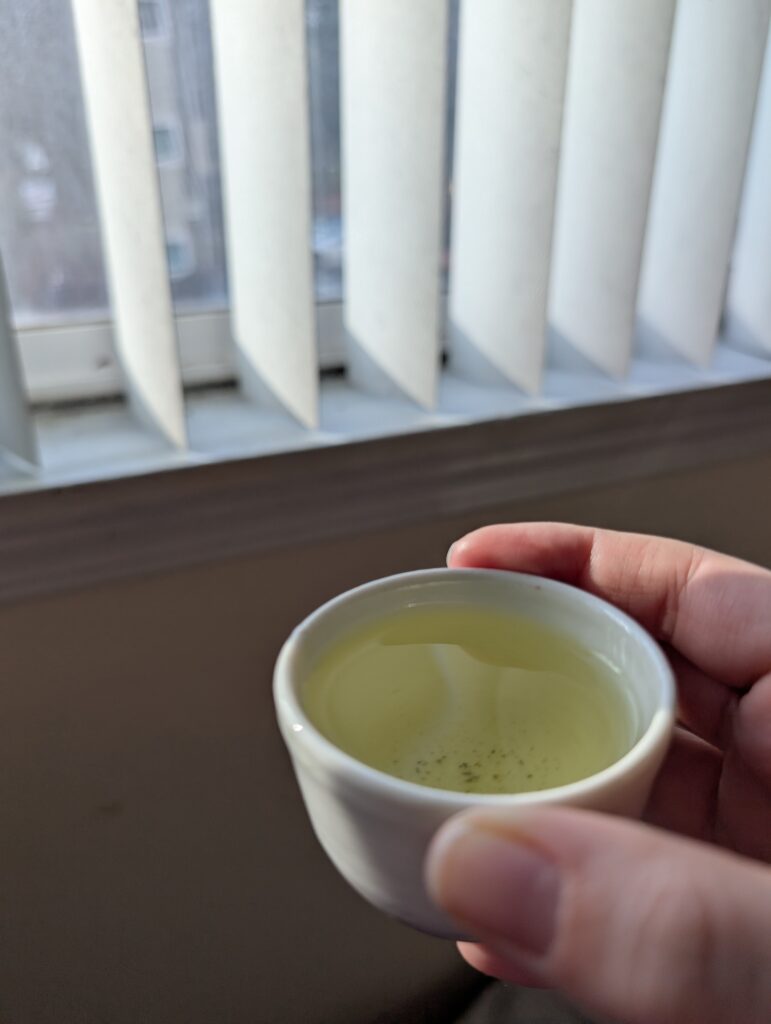
Sencha is a green tea with a history that goes back 300 years in Japan. As I mentioned earlier, it’s an infused tea, which means you steep whole tea leaves in hot water rather than using a powdered form like matcha. Sencha is known for its unique needle like shape, which sets it apart from other types of tea.
Types of Sencha/Green tea
Fukamushi Sencha
A deeply steamed sencha with a rich, bold flavor and vibrant green color. It has a strong umami taste and a cloudy liquid due to the finer particles that come from the longer steaming process. It’s known for its deep, green, and full-bodied flavor.
Asamushi Sencha
A lightly steamed sencha, known for its delicate flavor and clear, bright appearance. It has a milder, more floral taste compared to Fukamushi. I’ve never tried it myself, but it’s definitely on my list of teas to try!
Chumushi Sencha
A medium-steamed sencha that strikes a balance between the boldness of Fukamushi and the lightness of Asamushi. It offers a well-rounded flavor that combines elements of both.
Kabuse Sencha
This type of sencha is grown under shade for a short period of time before harvest, giving it a sweeter, more complex flavor. While not as intense as Gyokuro, it offers a nice balance of sweetness and depth.
Shincha
Often referred to as “new tea,” Shincha is the first harvest of the year, usually in the spring. It’s prized for its fresh, vibrant flavor and light, grassy taste, making it one of the most anticipated teas of the season. Definitely has more mellow tastes in my opinion.
Gyokuro Sencha
One of the highest-quality sencha varieties in Japan, Gyokuro is shaded for a longer period, resulting in a richer, more umami packed flavor. It’s known for its smooth, sweet taste and high-quality leaves. (I love to make unami bombs with this, haha. I steep it very nicely to make a big punch in the face with unami.)
Kamairicha
Kamaircha is produced by pan roasting/ pan firing the tea leaves to stop oxidation which gives it a nutty and roasty flavor.
Houjicha
Houjicha is a roasted green tea, typically made from bancha leaves. Bancha refers to the older, tougher leaves of the tea plant, which are harvested later in the growing season. These leaves are generally considered “mother leaves,” as they are more mature and have a stronger, more robust flavor. Roasting the leaves gives houjicha its unique, smoky aroma and a mellow, earthy flavor that is less grassy than other green teas. I love it in the rainy season or at night because it has less caffeine! Some people may even use it as a coffee replacement because of its flavor if you want to reduce caffeine.
Genmaicha
Genmaicha is a traditional Japanese tea made with bancha, similar to sencha and hojicha, but not roasted like hojicha. This tea is a unique blend of green tea and popped mochi rice, creating a nutty, cozy flavor.
Genmaicha is naturally lower in caffeine, making it a perfect, relaxing choice for evenings or cold winter days. It’s also fantastic when enjoyed iced or as a cold brew, giving it a refreshing twist.
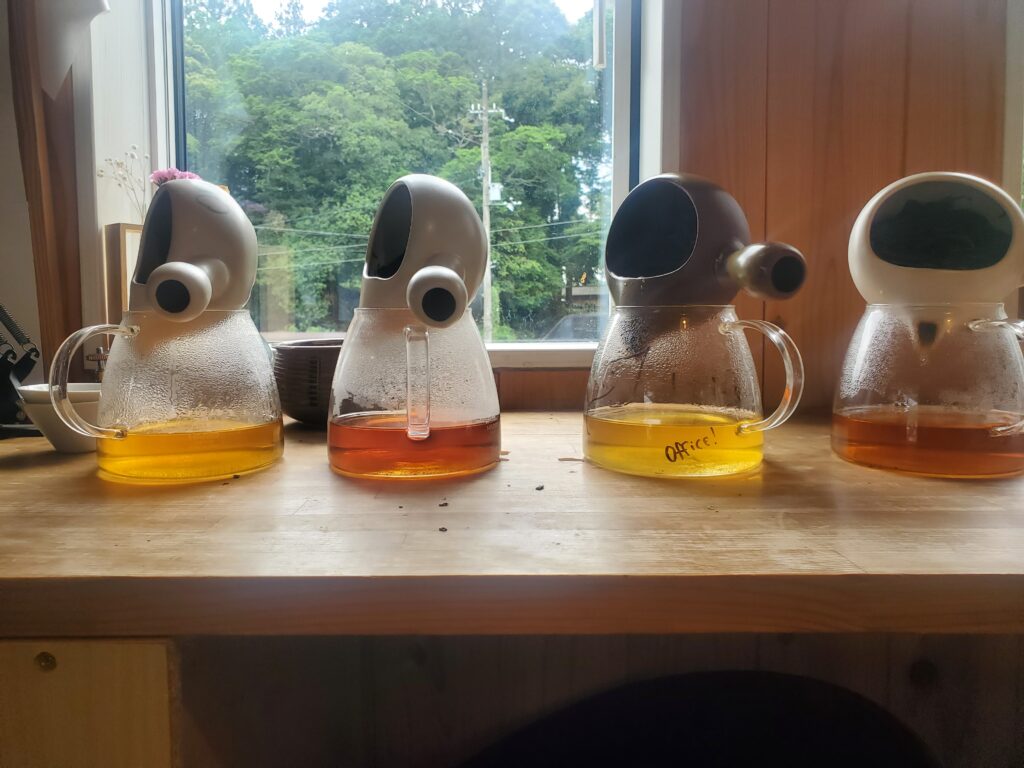
Japanese Oolong日本のウーロン茶
Japanese oolong isn’t as well known as oolongs from other regions, but let’s not write it off just yet. Oolong is a semi-oxidized tea, meaning the leaves undergo partial oxidation, allowing them to turn brown. It’s a tea that sits between green tea and black tea, with flavors ranging from light and floral to rich and robust.
Oolongs can vary significantly in taste, and Japanese oolongs are no exception. Some I’ve tried were floral, others earthy, and a few had a touch of astringency. However, most of the Japanese oolongs I’ve had were smooth, light in color, and truly beautiful teas.
Even though Japan doesn’t specialize in oolong like other countries, they certainly know how to craft it. I highly recommend everyone try a Japanese oolong at least once you might be surprised by it!
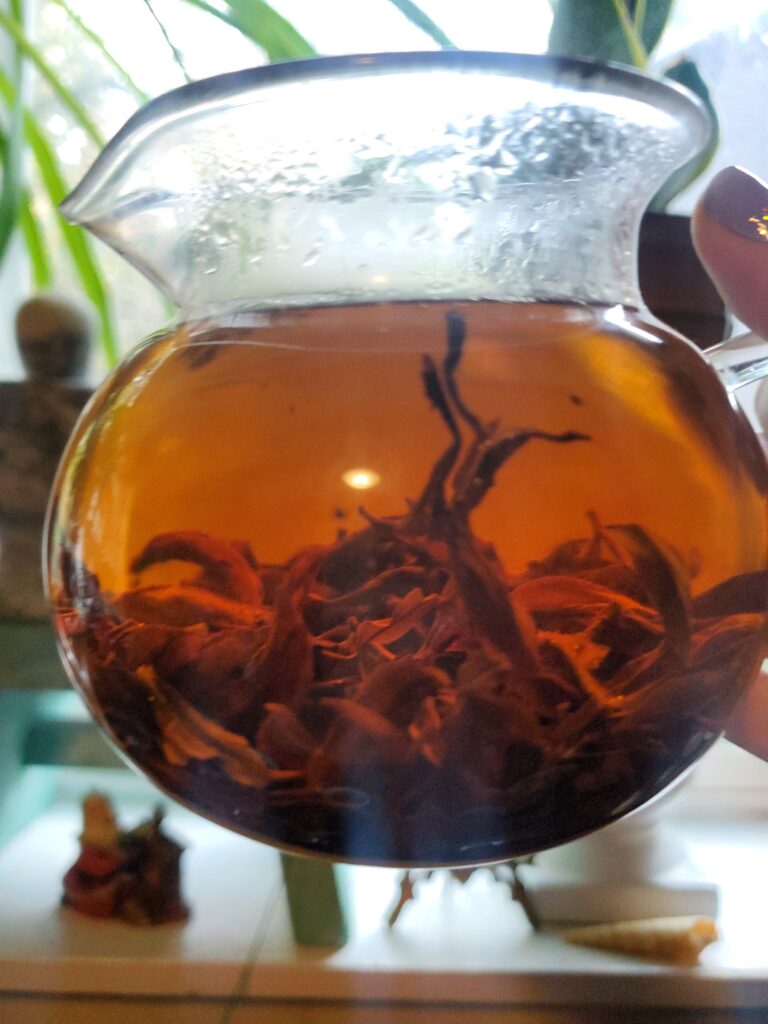
Wakoucha (Japanese black tea) 和紅茶
Japanese black tea, or wakoucha, is quite different from the traditional black teas we’re used to in Western countries. While Western black teas are often bold, bitter, and astringent, Japanese black teas are sweeter, smoother, and lighter, offering a much more pleasant and refined experience.
In the West, we typically add milk or sugar or sometimes both to our black tea, but with Japanese black tea, you don’t need to(at least, I don’t think you need to). The tea’s natural sweetness and smoothness make it perfect on its own.
During my time in Japan, I had the chance to try many different black teas and even make my own. The flavor profile is incredibly unique. The one I made tasted like honey, while others I had tasted had more smoky or earthy notes. Despite these differences, they all shared a sweeter undertone that sets Japanese black tea apart from what we’re used to.
It’s a lesser known tea of Japan, but I highly recommend giving it a try. Japanese black tea is an underrated gem that’s definitely worth experiencing. here is a blog on Wakoucha
Fermented Japanese Tea
Fermented tea is something you might associate with kombucha or other fermented beverages. In this case, it’s the leaves that are fermented, not the liquid. Originally, humans fermented teas as a way to preserve them and prevent them from spoiling.
I had the pleasure of trying several different types of Japanese fermented tea, and I can say the flavor profiles are quite distinct from those I’ve tried from other countries. Japanese fermented teas tend to be much more fruity almost like raspberry fruit leather in flavor. I find the taste to be very pleasant and unique, with an interesting and traditional method of preparation.
Some notable types of Japanese fermented tea include Awabancha and Goishicha (碁石茶). Both are great examples of how fermented tea is just as unique in Japan.
Here are some blog posts about the diffnt more about Awabancha and Goishicha
And that’s a wrap! I hope this gives you a better understanding of the fascinating world of Japanese tea and its unique varieties. If you have any comments or questions, feel free to leave them below. Thank you for reading!
